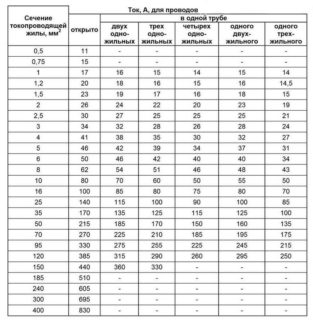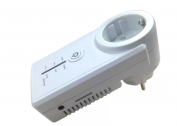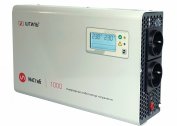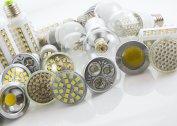Foreign manufacturers of household appliances have recently produced electric stoves and built-in ovens without wires. This is due to two significant reasons. Firstly, the structural features of the plug and voltage are different in many countries, and secondly, changes have been made to the safety requirements of the cooker and now they are installed in a wire-free way using terminal blocks (electrical appliances rated for currents from 32 A).
What cable for an electric stove do you need to buy
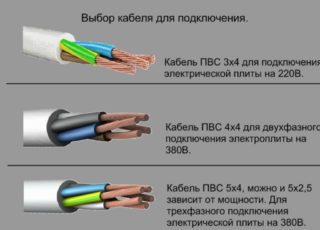 Any household appliances, in order to avoid troubles, must be connected in accordance with all the rules of the electrical installation (PUE). The features of connection and requirements listed in this publication are many years of experience of professionals in their field.
Any household appliances, in order to avoid troubles, must be connected in accordance with all the rules of the electrical installation (PUE). The features of connection and requirements listed in this publication are many years of experience of professionals in their field.
It is important to understand which wire is needed for connection and whether it is possible to connect the electric stove to a conventional outlet if it is decided to install household appliances on their own. The most important parameter required when determining the cross-section of the conductor for connecting an electric stove without a socket directly is the power of the consumed electricity.
Otherwise, there are not so many features of choosing a wire for a plate. Criterias of choice:
- possibility of use in rooms with a high level of humidity;
- acceptable price;
- excellent flexibility
- the permitted bending radius must be equal to at least 8 outer diameters of the section;
- double insulation equipment;
- possibility of application in electrical appliances with increased vibration.
Electricians recommend proceeding with the selection of the cable only after the following calculations: to the power consumed by the appliance, 20% of the number is added. Even without knowing the exact power of the equipment, you can purchase wires with a margin.
Electric power calculation
The power of electric stoves and ovens differs depending on the manufacturer and model modification. Typically, the values range from 5-8 kW.
The table shows the dependence of the main technical parameters. Using it is simple, just select the appropriate parameters based on the power value indicated in the passport to the appliance.
| Electric power | Cross section | |
| Single-phase network (3 cores, mm.kv.) | Three-phase network (5 cores, mm.kv.) | |
| Up to 3 kW | 1,5 | 1,5 |
| 3 to 5 kW | 2,5 | |
| 5 to 7.5 kW | 4 | 2,5 |
| 7.5 to 10 kW | 6 | |
The table shows the cross section of a copper cable, since it is the most suitable for installing an electric stove.
Type of material and cable cross section for board
To connect the electric stove to a three-phase outlet, it is necessary to connect the latter with the plug-in connection of the appliance. In this case, the main requirement for the type of cable is its flexibility. Wires equipped with rigid conductors are much more difficult to lay compactly behind a plate, as a rule, they stick out in all directions.
The flexible wire is equipped not with a monolithic conductive core, but with a large number of wires assembled in a bundle. This ensures freedom of movement.
Information about the wire and cable of the PVS and KG grades
The most optimal heat-resistant wires for electric stoves are cables of the PVS and KG brands. The sheath and insulation of the wires of the KG cable is made of high quality rubber. The advantage of this material lies in the wide operating temperature range, which ranges from -40 to +50 degrees, as well as in resistance to sunlight. The abbreviation is deciphered as follows: K - cable, G - flexible.
In various industries, it is used to connect moving mechanisms, for example, hoists, crane beams, etc.
The abbreviation PVA is deciphered as follows: P - wire, B - vinyl insulation of conductive cores and shells, C - connecting. Thus, PVA is a cable, not a wire. However, it is often used when conducting wiring in apartments and country houses. Its main purpose is application on sections of the household network where increased flexibility is required. Extenders and power cords are made from it. The operating temperature range ranges from -25 to +40 degrees. The advantage of the material is its resistance to burning, it does not spread fire, as it simply melts.
Cable section
The choice of wire cross-section depends on the power of the electrical device. To connect a three-phase or single-phase equal power, cables of different sections are required. This is due to the fact that in the second case, the entire power of the electrical device is carried out in one phase, and in the first it is divided between three.
Features of connection and grounding
You can connect the electric stove in two ways - through the terminal strip or a special outlet for the stove in the kitchen. In Russia, the second option is still most in demand. The connection algorithm is as follows:
- The most suitable location for installing the equipment is determined. Electric stoves can not be placed near window and doorways, iron pipes and washstands.
- A power outlet with an earthing contact is mounted at the required height. The socket must have a current rating in the range 32-40 A.
- In the electrical panel, a separate automatic machine is additionally mounted on the stove. For two- or three-phase at 16 A, for single-phase at 25-30 A.
- A wire or cable extends to the receptacle from the shield.
- The plug of the socket is connected to the flexible wire of the electric stove or the oven.
- A flexible wire connected to a plug connects to an electrical appliance. To do this, remove the back cover of the plate, which restricts access to the terminals.
- The power cable in the electrical panel is divided into cores, the ends of each wire are cleaned before connection. Phase conductors are connected to the strip clamps of the machine, and a zero core is connected to the bus.
It is strictly forbidden to do grounding on the zero bus, since it is very hot. The phase will return to the device, and the user may be shocked.
Grounding at home is carried out in two ways: with the absence of a grounding circuit and the presence of a common grounding circuit. In the first case, the additional installation of RCDs, as well as the implementation of grounding, will solve the problem. In the second case, you will need a flexible wire made of copper with a cross section of at least 2.5 mm.sq. It is carried out from the electrical panel and brought to the body of the electrical device.
In houses or apartments where there is no central gas supply, an electric stove or built-in oven will help to solve the cooking problem. To use the device was comfortable, you need to install it and connect it correctly. When buying a cable or wire, you need to pay attention to the manufacturer of the product, the cross section and length, as well as the brand.
